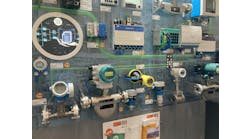Don’t be afraid to explore new process control and automation technologies
[sidebar id =1]Notice anything different? This column may seem like the same old text, but much of it’s coming to you from the miracle of voice-to-text technology. Yes, less hunt-and-peck on the keyboard and more speaking into the microphone, but still editing onscreen.
Of course, we’ve long been aware of increasingly sophisticated voice-recognition software like Dragon and others, but I always assumed they were too costly, complex or difficult to use, and so even my slow typing could make up for any gains that voice-to-text might generate. If it’s not broke, don’t fix it, right?
How wrong I was. While I didn’t invest in new software, I discovered that the digital notes, messaging and email on my smart phone and laptop PC have little microphone icons, which can enable their voice-to-text tools. And, instead of the often-garbled text that old voice-recognition software used to produce, today’s phone-based versions deliver text that’s pretty much clean. Sweet. A powerful tool to help me produce stories faster, plus I finally found a way to permanently avoid learning touch typing.
This happy ending—and the microphones—reminded me of when we first starting recording audio podcasts and shooting videos about control and automation several years ago. Just like with voice-to-text, the whole format and process felt awkward, alien and impossible, until I discovered that I could ask the same questions in a podcast or video that I ask for print or online stories. I felt much better knowing my nosy, rambling queries could go on, and that I could continue seeking useful answers, even if it was in a different format.
[pullquote]As you’ve likely guessed, I’m telling you about my format struggles because I think the same reflexive reluctance affects many potential users of the process control and automation technologies I write—and speak—about. Several sources have told me that most users are still only using HART protocol for configuration, but not for communicating the routine operations data it could bring in all the time. This is nuts because HART already resides in millions of devices, and could provide boatloads of useful data if users would just turn it on, and grab the business intelligence and benefits it can deliver.
Likewise, years after they simplified point-to-point networks, the other fieldbus protocols also remain way less utilized than they should be. Granted, Ethernet and wireless have made a big dent, but don’t tell me they’re anywhere near reaching their potential. I don’t have hard data to back up my opinion, but I can report that at least half of the case studies I’ve run into lately are about users moving from manual to automated process controls or from point-to-point networks to fieldbuses for the first time.
[sidebar id =2]More recently, Ethernet networking and components with embedded microprocessors, Internet protocol (IP) links and internal webpages are expected to remove more hurdles between operations and decision-makers, and allow them to participate in the Industrial Internet of Things (IIoT). However, these advantages can’t be gained if users don’t enable the components to reach them. Unfortunately, many potential users still think of today’s streamlined, inexpensive, point-and-click software and plug-and-play devices as having the same programming requirements, high costs and other difficulties as they did many years ago.
These old mindsets have to change. Our biological brains simply have to do better jobs of catching up with the innovations and simpler, easier tools that other brains have developed.
I know most process applications are delicately balanced, often potentially explosive, and that the process industries are typically conservative, slow-moving and losing many veterans with the same characteristics. However, it’s important to make sure that caution isn’t a cover for inertia, laziness and calcification. So, prove it by checking out some new tools, and see how much easier they are to use than you thought they were. If I can try it, anyone can.




